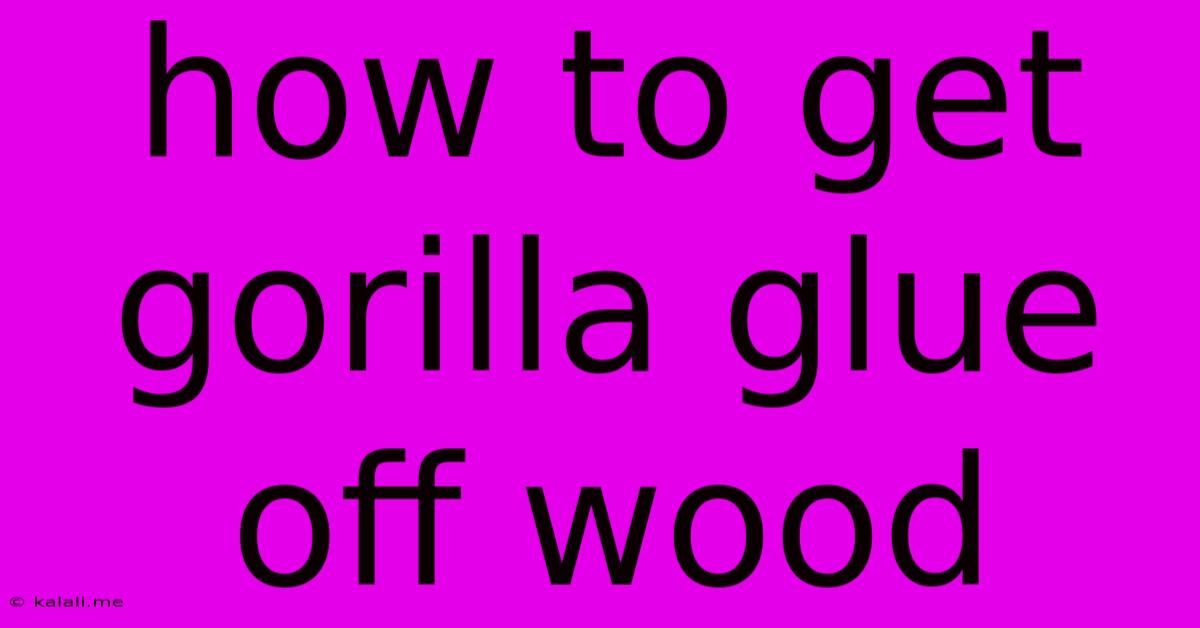How To Get Gorilla Glue Off Wood
Kalali
Jun 03, 2025 · 3 min read

Table of Contents
How to Get Gorilla Glue Off Wood: A Comprehensive Guide
Gorilla Glue, while incredibly strong and versatile, can be a nightmare to remove if accidentally applied incorrectly. This comprehensive guide will walk you through various methods to effectively remove Gorilla Glue from wood, minimizing damage to your cherished project. Whether you're dealing with a minor spill or a larger mishap, we've got you covered.
Understanding the Challenge: Gorilla Glue's exceptional strength stems from its expansion during curing. This expansion, combined with its powerful bond, makes removal a significant challenge. Attempting brute force will likely damage the wood. Therefore, a strategic approach is key.
Method 1: Prevention – The Best Removal Technique
The best way to deal with Gorilla Glue on wood is to prevent it from getting there in the first place! This involves careful application, using clamps to secure pieces while the glue dries, and working in a well-ventilated area to avoid accidental spills.
Method 2: Isopropyl Alcohol (Rubbing Alcohol)
This is often the first line of attack, especially for fresh spills. Isopropyl alcohol (IPA), preferably 90% or higher concentration, can soften the glue, making it easier to scrape away.
- Step 1: Apply the IPA liberally to the glued area, ensuring the glue is thoroughly saturated.
- Step 2: Let it sit for several minutes, allowing the alcohol to penetrate the glue.
- Step 3: Gently scrape away the softened glue using a plastic scraper or a dull knife. Avoid using metal tools, as these could scratch the wood.
- Step 4: Repeat the process as needed until the majority of the glue is removed. Remember to be patient; this may take multiple applications.
Important Note: This method is most effective on fresh glue. The longer the glue has to cure, the less effective this method will be.
Method 3: White Vinegar
White vinegar offers a gentler approach than IPA, particularly for delicate woods.
- Step 1: Saturate the glue with white vinegar.
- Step 2: Allow it to soak for a considerable amount of time (possibly several hours, or even overnight).
- Step 3: Use a plastic scraper or stiff brush to gently remove the softened glue.
- Step 4: Repeat as necessary. Vinegar's effectiveness relies on its acidic properties slowly breaking down the glue.
Method 4: Heat and Scraping
This method should be used with extreme caution, as excessive heat can damage the wood.
- Step 1: Carefully apply heat to the glued area using a hairdryer (on low heat) or a heat gun (on a low setting, and at a distance to prevent burning).
- Step 2: Monitor the wood closely for signs of discoloration or damage.
- Step 3: Once the glue begins to soften, gently scrape it away with a plastic scraper.
Caution: Always test this method on an inconspicuous area of the wood first to ensure it doesn't damage the finish.
Method 5: Commercial Glue Removers
Several commercial glue removers are available on the market specifically designed to tackle Gorilla Glue. These often contain solvents that effectively break down the adhesive bond. Always follow the manufacturer's instructions carefully.
After Removal:
After removing the Gorilla Glue, gently sand the area to smooth out any remaining residue and restore the wood's finish. You may need to refinish the affected area depending on the severity of the glue application and the type of wood.
By following these methods, you can effectively remove Gorilla Glue from wood while minimizing damage. Remember that patience and a careful approach are crucial for success. Choose the method that best suits your situation and always prioritize the preservation of your wood.
Latest Posts
Latest Posts
-
T Sql List Columns Field Of Table
Jun 04, 2025
-
The Benefit Of The Doubt Meaning
Jun 04, 2025
-
Why Was The Codex Important To The Cryptonians
Jun 04, 2025
-
Red River Group Home The Boys
Jun 04, 2025
-
In My Experiene Or From My
Jun 04, 2025
Related Post
Thank you for visiting our website which covers about How To Get Gorilla Glue Off Wood . We hope the information provided has been useful to you. Feel free to contact us if you have any questions or need further assistance. See you next time and don't miss to bookmark.